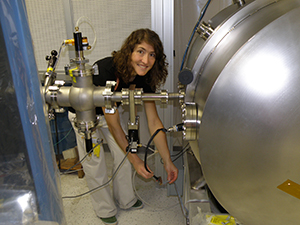June 21, 2013 In The Loop: Van Allen Probes Team Member Selected For NASA Astronaut Training  Christina Hammock at work at the Johns Hopkins University Applied Physics Lab, using a particle accelerator to test the Jupiter Energetic-particle Detector Instrument (JEDI, now flying aboard the NASA Juno mission to Jupiter, which launched in 2011). This particle accelerator was also used to test the Van Allen Probes’ RBSPICE instruments. Photo credit: C. Hammock/JHUAPL
Christina M. Hammock, who has worked since 2007 at the Johns Hopkins University Applied Physics Laboratory in Laurel, Md., was selected on June 18 as one of eight finalists for NASA astronaut training. Hammock, a native of Jacksonville, N.C., was one of 6,300 applicants; in August, she and the other seven candidates will head to NASA’s Johnson Space Center in Houston to begin two years of training that could culminate in a mission to the International Space Station, among other potential targets. It is NASA’s first new astronaut candidate class in four years. “It feels incredible and it makes me feel like all my hard work was worth it,” Hammock said to the media on her selection. “I also realized it’s not always hard work if you’re doing what you love and following your dreams.” Long-distance travel – whether across the globe or into orbit – is an area in which Hammock specializes. She’s currently station chief of a National Oceanic and Atmospheric Administration (NOAA) Climate and Atmospheric Observatory in American Samoa; she has also covered much the globe (including Greenland and the South Pole) for work, research and adventure travel. When her training begins, Hammock says she’ll be counting in part on her experiences and knowledge from her time at the Lab. “It's hard to think of something that I learned at APL that won't be invaluable during training!” she writes via e-mail from American Samoa. “More seriously, the experience of working on a close team and cross-department coordination is something I expect to draw on a lot. The technical aspects of the instrument engineering will come in handy when learning about the space station systems and experiments.” “The entire APL community, and particularly the Space Department, is tremendously proud of Christina’s accomplishment,” says Kurt Lindstrom, Civil Space Business Area Executive at the Lab. “We are going to miss her skills and talents, but we know she has the chance to achieve a lifelong dream, and we wish her the best of luck – and look forward to seeing her soar above Earth.” While at APL, Hammock worked for the Space Science Instrumentation (SRI) group on several projects. Most of her work focused on three particle detector (called the “hockey puck”) instruments: the Jupiter Energetic-particle Detector Instrument, or JEDI (on Juno, launched 2011), the Van Allen Probes’ Ion Composition Instrument, or RBSPICE, (Van Allen Probes, launch 2012), and similar devices for the upcoming Magnetospheric Multiscale Mission, or MMS (launching 2014). For RBSPICE, “my main role was as the lead engineer of the sensor subsystem that measured the total energy of the particles,” Hammock says. “In this role, I was privileged to work both with [REDD’s Engineering, Analysis and Fabrication group] on device fabrication and testing as well as the science team on the data products of the detectors. I also would like to thank Reid Gurnee and Kevin Heffernan for their support and encouragement as phenomenal supervisors!” “She was scheduled to rejoin our group in another few months to work for 18 months or so, but it looks like that is not going to happen now,” jokes SRI’s Steve Jaskulek, with whom she worked on the detectors. “We are all thrilled that she is going to be able to live her dream, and we are all very proud of her.” While at APL, “I really enjoyed working on brand-new technologies,” Hammock says, “such as when I was lucky enough to be paired with Kim Strohbehn and we came up with something novel that ended up being a nominee for Invention of the Year at APL. The development platform for our device had grown by the week until it ended up a tall, sprawling manifold of tubes and vacuum plumbing that even quickly out-grew its original name of ‘The Pretzel.’ It happened to be in a lab by the break room, so we got a lot of traffic and constant comments about our ‘Rube Goldberg’ contraption. But it worked!” She was unable to watch the Aug. 30, 2012 launch of the Van Allen probes because she was traveling to American Samoa, but says “I watched the news closely and have enjoyed posting all the success stories and discoveries as they happen. Also, before RBSPICE, our team launched [in 2011] a very similar instrument suite called JEDI on the Juno mission to Jupiter. I was able to attend that launch in Florida and it was an incredible feeling!” Hammock says that, more than anything else, “APL taught me how to work harder than I ever thought I could. I used to say that I discovered a whole new ‘high gear’ that I didn't even know I had! APL helped me learn to stay focused and efficient while keeping a sense of humor and having fun – and of course, what to order for delivery when your team is having a late night of problem-solving is key!” The positive experiences she had at APL will help her as she tackles her toughest challenge to date. “My main memory is how close a team of folks who are working toward the same goal can get,” she says, “and how lucky I feel to have been a part of that team. When things weren’t going well and we were all in the lab late, brainstorming or putting in long hours preparing for a big review, it makes the eventual successes all the more profound and exciting.” The Van Allen Probes are part of NASA's Living With a Star Program to explore aspects of the connected sun-Earth system that directly affect life and society. LWS is managed by the agency's Goddard Space Flight Center in Greenbelt, Md. APL built the Van Allen probes and manages the mission for NASA. |

